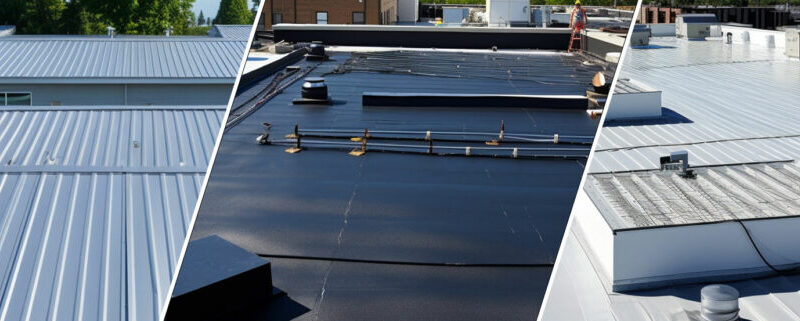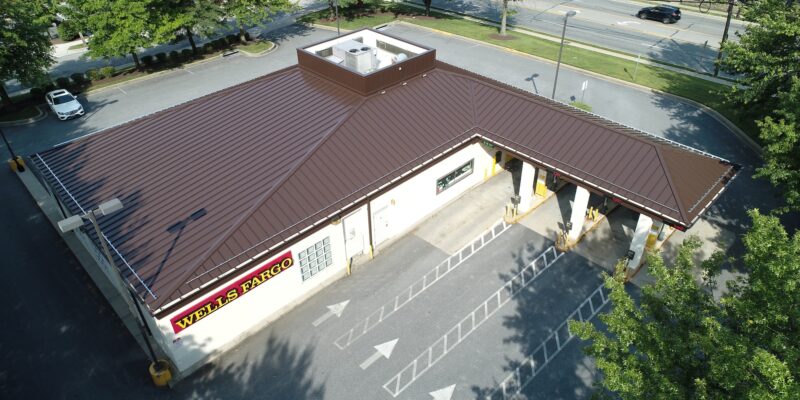When it comes to commercial roofs, there are a variety of good available, each with its own
unique features and benefits. Understanding these different types is crucial for making informed
decisions about roof installation or repair. So, in this article, we will explore the different types of
commercial roofs and explain their key characteristics.
Flat Commercial Roofs
Flat roofs are a popular option for commercial buildings due to their versatility and cost-
effectiveness. They are commonly found in warehouses, retail centers, and office buildings. One
of the main advantages of flat roofs is their accessibility, making it easier for maintenance and
installation of HVAC systems, solar panels, and other equipment.
However, flat roofs also have their disadvantages. One major concern is their limited drainage
capabilities. Since flat roofs don't have a slope, water can pool and cause leaks or damage over
time. Regular inspections and proper maintenance are crucial to prevent these issues.
Additionally, flat roofs may require more frequent repairs compared to other types due to their
susceptibility to leaks.
Despite these drawbacks, flat roofs offer several benefits. They provide ample space for rooftop
gardens, recreational areas, or additional storage. Moreover, the installation of a reflective
coating can improve energy efficiency by reducing heat absorption and lowering cooling costs.
Roofing material options include:
Metal Roofs:
Metal roofs are known for their durability and longevity, making them a reliable option for
commercial buildings. They can be made of steel, aluminum, or copper, providing excellent
protection against the elements. Metal roofs are also highly resistant to fire, rot, and pests,
making them a low-maintenance choice.
One of the key advantages of metal roofs is their energy efficiency. They reflect sunlight,
reducing the heat transfer into the building during hot weather. This can result in lower cooling
costs and increased energy savings over time. Additionally, metal roofs are recyclable, making
them an environmentally friendly choice.
However, metal roofs also have their disadvantages. They can be noisy during heavy rain or
hailstorms, requiring additional insulation to minimize sound transmission. Metal roofs can also
be more expensive to install compared to other options. However, their long lifespan and
minimal maintenance requirements often make up for the initial investment.
TPO Roofs:
TPO (thermoplastic olefin) roofs have gained popularity in recent years due to their versatility
and energy efficiency. They are made of a single layer of synthetic material that is highly
resistant to UV rays and weathering. TPO roofs are available in various colors and thicknesses,
allowing for customization to suit different aesthetic preferences.
One of the main advantages of TPO roofs is their ability to reflect sunlight, reducing heat
absorption and improving energy efficiency. This can result in significant cooling cost savings
over time. TPO roofs are also highly resistant to punctures, tears, and mold growth, making
them a durable option for commercial buildings.
However, TPO roofs may not be suitable for all climates. In areas with extreme temperature
fluctuations, TPO roofs can expand and contract, potentially leading to cracks or leaks. Proper
installation and regular inspections are crucial to prevent these issues. Additionally, TPO roofs
may have a shorter lifespan compared to other options, depending on the quality of the material
and installation.
EPDM Roofs:
EPDM (ethylene propylene diene terpolymer) roofs are another popular choice for commercial
buildings. They are made of a synthetic rubber material that provides excellent resistance
against UV rays, weathering, and temperature fluctuations. EPDM roofs are known for their
durability and low maintenance requirements.
One of the key advantages of EPDM roofs is their long lifespan. With proper installation and
regular maintenance, EPDM roofs can last up to 30 years or more. They are also highly resistant to punctures, tears, and ozone damage. EPDM roofs are available in different thicknesses, allowing for customization based on specific building requirements.
However, EPDM roofs may not be as energy-efficient as some other options. They have a lower
reflectivity compared to TPO or metal roofs, which can result in increased cooling costs during
hot weather. EPDM roofs may also require regular inspections to identify any potential issues
and prevent leaks.
PVC Roofs:
PVC (polyvinyl chloride) roofs are known for their durability, energy efficiency, and versatility.
They are made of a single layer of synthetic material that provides excellent resistance against
UV rays, chemicals, and weathering. PVC roofs are available in various colors and thicknesses,
allowing for customization to suit different architectural styles.
One of the main advantages of PVC roofs is their exceptional energy efficiency. They have a
high reflectivity, reducing heat absorption and lowering cooling costs. PVC roofs are also highly
resistant to fire, punctures, and moisture, making them a durable option for commercial
buildings.
However, PVC roofs may not be suitable for all climates. In extreme cold temperatures, PVC
roofs can become brittle and prone to cracks. Proper insulation and regular maintenance are
crucial to prevent these issues. Additionally, PVC roofs may have a higher initial cost compared
to other options, although their long lifespan and energy savings often outweigh the upfront
investment.
Green Roofs:
Green roofs, also known as living roofs or eco-roofs, are gaining increasing popularity in
commercial buildings. They involve the installation of vegetation and plant life on the roof
surface, providing several environmental benefits and improving energy efficiency.
One of the main advantages of green roofs is their ability to reduce stormwater runoff and
improve water management. The vegetation absorbs rainwater, reducing the load on drainage
systems and preventing flooding. Green roofs also act as natural insulators, reducing heat
transfer and lowering cooling costs. They can improve air quality by filtering pollutants, noise
reduction, and provide aesthetic value to the building.
However, green roofs require additional considerations and maintenance compared to other
options. They require proper irrigation, regular inspections, and periodic maintenance to ensure
the health and longevity of the vegetation. The structural integrity of the building must also be
assessed to ensure it can support the additional weight of the green roof.
Built-Up Roofs:
Built-up roofs (BUR) are a traditional roofing system consisting of multiple layers of asphalt and
gravel. They are known for their durability, waterproofing capabilities, and long lifespan. BUR
roofs are commonly found in commercial buildings with low-slope or flat roofs.
One of the main advantages of BUR roofs is their ability to provide excellent protection against
weathering, UV rays, and fire. The multiple layers of asphalt and gravel create a strong and waterproof barrier. BUR roofs are also highly resistant to punctures and can withstand foot traffic during maintenance or repairs.
However, BUR roofs can be more expensive and time-consuming to install compared to other
options. The multiple layers require careful installation and proper sealing to ensure the roof's
integrity. Additionally, BUR roofs may require periodic maintenance, such as resealing or
patching, to prevent leaks and extend their lifespan.
Choosing the Right Type of Commercial Roof for Your Building
Choosing the right type of commercial roof is a crucial decision that can impact the longevity,
energy efficiency, and overall performance of your building. Factors to consider include the
climate, building structure, budget, and specific requirements.
Consulting with a professional roofing contractor is highly recommended to assess your
building's needs and provide expert advice. They can evaluate the structural integrity, assess
the climate considerations, and recommend the most suitable roofing system for your
commercial building.
Regular inspections and maintenance are essential to ensure the optimal performance and
longevity of your chosen roof system. Addressing any issues promptly can prevent costly
repairs or replacements down the line.
Understanding the different types of commercial roofs and their advantages and disadvantages
is crucial for making an informed decision. By considering factors such as durability, energy
efficiency, maintenance requirements, and cost, you can choose the right type of commercial
roof that suits your specific needs and ensures the long-term success of your building.




